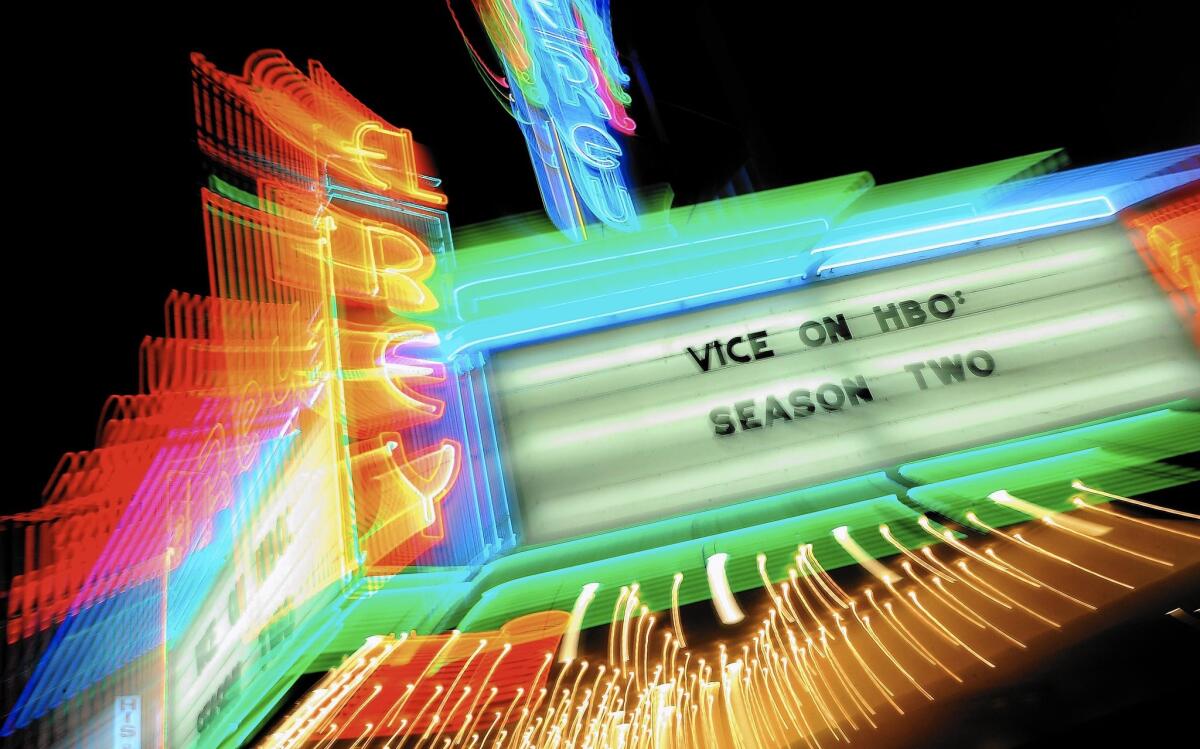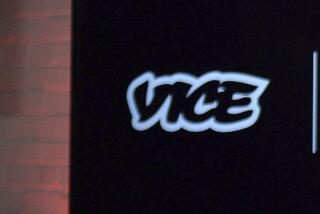HBO expands its offerings of Vice content

Perhaps the biggest strategic move by HBO is giving Vice a dedicated channel on HBO Now, a streaming service set to launch next month and geared toward viewers who prefer phones and tablets over TV.
- Share via
HBO is expanding its relationship with Vice, the renegade media brand that’s become a favorite among millennials hunting for edgy news content.
The premium cable network will for the first time air a nightly newscast produced by Vice, an ambitious undertaking to attract the kind of rabid, younger fans that made Jon Stewart a hit. The deal also calls for more episodes of the Emmy award-winning newsmagazine “Vice,” along with an increased number of long-form documentaries.
But perhaps the biggest strategic move by the Time Warner Inc. cable unit is giving Vice its own dedicated channel on HBO Now, the network’s stand-alone streaming service set to launch next month. It demonstrates that HBO is doubling down on a growing generation of viewers who prefer smartphones and tablets rather than televisions to view content.
“HBO gets the wealth of our experience with digital and the [millennial] demo and we get the wealth of their experience — obviously they are the best at TV and film,” Vice founder Shane Smith said in an interview with The Times. “Together we are stronger.”
Financial terms of the deal were not disclosed.
Smith, who also hosts Vice’s show on HBO, founded the company in 1994 as an edgy Montreal culture magazine. He’s since built it into one of America’s hottest media properties, with digital channels, a television and feature film production studio, a magazine, a record label and a book-publishing division.
The company, based in the hipster enclave of Williamsburg in Brooklyn, delivers the kind of audience that HBO is trying to tap in its digital endeavors. For instance, Vice reports that 80% of people tuning in to Vice News are ages 15 to 34.
That’s a prime demographic for HBO as it prepares to launch its streaming service aimed at attracting subscribers who have cut the cord to expensive cable bundles.
There are about 10 million homes in the U.S. with high-speed Internet service but not a pay-TV subscription. Younger adults are more inclined to get their entertainment from a variety of streaming services rather than sign up for a $100-a-month pay-TV subscription.
The digital streaming platform will cost $14.99 a month, and give users access to its library of movies and original programming, along with Vice’s content. HBO Now was unveiled earlier this month at an Apple event in San Francisco.
“It’s just a smart move,” said Alan Wolk, an analyst with Texas-based research firm Diffusion Group. “This gives people, especially young viewers who are hard to pin down, a reason to go there every day.”
Wolk said this shows there’s an “opening for a new personality for millennials to get their information from.” Further, he believes Vice could be in a strong position to attract viewers as the 2016 presidential election heats up.
News has been a sweet spot for younger viewers since Stewart launched his Emmy award-winning “The Daily Show” on Comedy Central in 1996. The satirical newscast was a hit with younger viewers, and helped make popular a genre of topical shows on cable that includes John Oliver and Bill Maher on HBO.
And in an era of binge-watching, it’s the kind of agreement that offers young viewers added incentive to keep coming back to HBO even once they’ve caught up on “Game of Thrones” or “The Jinx.”
Smith said in order to attract millennials to news, the company aims to use “language and a way of storytelling that resonates.”
“You have to have young producers, shooters and hosts that speak to them,” Smith said. “We come at things from a different point of view. Sometimes we don’t even comment, we just live stream. I think we also make documentaries that look at things before, during and after the news cycle leaves.”
HBO declined to comment. But in a press release Thursday, Richard Plepler, CEO of HBO, and Michael Lombardo, president, HBO programming, expressed enthusiasm for the deal, calling Vice’s journalism “groundbreaking and dynamic.”
The content deal, which Smith said is the largest in Vice’s history, also ignited more speculation about his company’s future — and whether it will seek out an initial public offering.
Vice was valued at more than $2.5 billion last summer after A&E Networks took a 10% stake for $250 million. The network is a joint venture of Walt Disney Co. and Hearst.
Time Warner had also been in talks last year with Vice about an investment, but those negotiations fell through.
Before that, Rupert Murdoch’s media company invested $70 million in the operation for a 5% stake in August 2013. In a tweet in 2012, Murdoch called Vice a “wild, interesting effort to interest millennials who don’t read or watch established media. Global success.”
But, Smith said — for the time being, at least — “it’s been best for us to stay independent.”
He also didn’t rule out other big content deals in the future.
A&E Networks has had on-and-off conversations with Smith about converting one of A&E’s existing television channels into a Vice-branded entertainment channel as an outlet for the company’s documentaries and other programming, according to a person familiar with the talks.
Smith said Vice is “still exploring all possibilities,” including other potential partnerships.
“If other people come and allow me perfect deals that increase my scale ... as well as build my brand, then we’ll look at those types of deals,” he added.
Times staff writer Meg James contributed to this report.
More to Read
From the Oscars to the Emmys.
Get the Envelope newsletter for exclusive awards season coverage, behind-the-scenes stories from the Envelope podcast and columnist Glenn Whipp’s must-read analysis.
You may occasionally receive promotional content from the Los Angeles Times.












